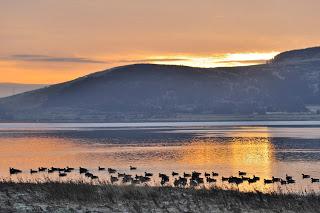
© SNH-Lorne Gill
Loch Leven’s water quality has improved hugely over the past 25 years, according to research carried out by NERC Centre for Ecology & Hydrology (CEH), Scottish Natural Heritage (SNH) and partners.Twenty-five years ago, in June 1992, Loch Leven was visibly blighted by poisonous, blue-green algal blooms and murky water. The event became known locally as “Scum Saturday.” It was estimated to have cost the local community more than £1M in lost revenue.Loch Leven is Scotland’s largest lowland loch and an internationally important wildlife site. As a result, there were strong calls for action to stop this algal blight happening again and plans to clean up the loch were put in place.Levels of pollution, mainly caused by excessive amounts of phosphorus entering the loch, have been falling over the last 25 years. This has led to improvements in water clarity, increases in the abundance and diversity of aquatic plants, better habitat, and more food for fish and birds. The improved water clarity, in particular, illustrates this dramatic change, with visibility increasing from under 1m at its worst to now nearly 5m deep.This restoration has come about from the many years of hard work by the catchment management group, formed 25 years ago. The group and many other local organisations have completed a number of innovative actions in the first catchment plan of its kind in Scotland. SNH, SEPA, Scottish Water and Perth & Kinross Council, and others in the community, have worked hard to improve the water quality of the loch.Existing sewage works have been upgraded and a new one built; local authority policies have been changed to ensure that strict waste water treatment arrangements are incorporated into any new build. As well, grass buffer strips on field margins and soil retention areas have reduced soil erosion and the woolen mill has stopped discharging pollutants into the loch.The world renowned CEH team has monitored the water quality at Loch Leven for almost 50 years. Over the first 20 years (1968-1987), the loch suffered serious degradations in water quality due to the combined effects of eutrophication (due to phosphorus from agriculture, sewage and industry), pesticide pollution and climate change. However, after the variety of management interventions which started in the early 1990s, the site underwent a slow, but sustained, recovery. The improved water clarity has allowed light to reach down to deeper levels. By 2007, water quality had improved and aquatic plants (such as pondweeds and stoneworts) had returned to deeper water.However, a recent study by CEH, SEPA, PKC and SNH found that, while discharges to the loch from sewage treatment works and industry have been decreasing, phosphorus concentrations have started to increase again. This could be due to some septic tank systems not working as efficiently as others in some areas and to possible land use problems in some parts of the catchment associated with the increasing intensity of storm events due to climate change. The management group is currently looking into these issues.Denise Reed, SNH Tayside & Grampians Area manager, said:“Loch Leven is a terrific natural asset to Kinross-shire. Thanks to the hard work of many organisations and people in the Kinross area, it’s in better shape now than it’s been for many years. But there’s still plenty of work to do and we and our partners are committed to doing everything that we can. It’s important to make sure that the loch’s water remains clean and healthy, so that wildlife can thrive and people can enjoy their visits to the loch even more.”Dr Linda May of CEH, who has led the monitoring programme for the last twenty years, said:“The enormous improvement in water quality at Loch Leven over the last 25 years, and the associated improvements in food and habitat for wildlife provide a world-leading example of what can be achieved when scientific evidence is used to underpin restoration and management activities. Lessons learned at Loch Leven are now being used to inform lake restoration projects across the world, especially in developing countries. Our achievements at Loch Leven are frequently described by scientists and lake managers alike as ‘inspirational’.”Jamie Montgomery from Kinross Estate Agency added:Water quality is crucial to the health of the fishery. The dramatic improvement in quality over the last 25 years has undoubtedly resulted in Loch Leven’s brown trout being in the best condition that anyone can remember, due to the range of food sources that the loch now offers. Having almost been wiped out 30 years ago, the pike and perch populations have recovered strongly as well.Wull Dryburgh, SEPA Catchment Co-ordinator, said:“In general, Loch Leven is an example of the cumulative effect of lots of small-scale discharges from a variety of sources – on their own they may seem fairly insignificant, but on a catchment-wide scale they can build up to a big problem. These discharges include run off from agricultural land which SEPA is tackling through diffuse pollution priority catchments and Loch Leven has been chosen for this approach in 2018/19.“By visiting farmers and land managers and discussing farming practice, our staff can see if there are any areas that need tightening up, such as animal housing, pesticide fill/mix areas and fuel storage. We’ve already had success in a number of areas in Scotland, seeing compliance rates rise from 36% to 84%. An improvement like this could make a real difference to water quality in Loch Leven and build on the good work already done in the catchment by various bodies, farmers and land managers to minimise diffuse pollution impacts.”It’s important to re-establish good water quality at this site for many reasons, including to sustain its many designated conservation features (SSSI, SPA, Ramsar site & NNR) and to meet its European Union Water Framework Directive targets.
